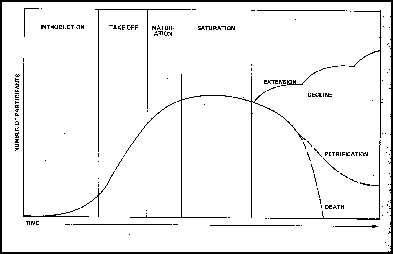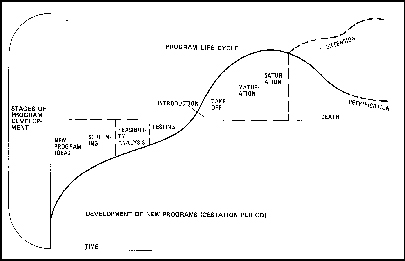Let's Stop Running Cave Tours!
The Problem
Since the 1820s, various private entrepreneurs and governmental agencies have been conducting cave tours. During the 19th century, caves, and Jenolan Caves in particular, were among the tourism destinations of Australia. All tourism tended to diminish during the inter-war period, but in the 1970s with a new recognition of the Australian natural environment, the popularity of cave destinations grew rapidly. This was followed by a plateau in visitor numbers during the 1980s (Hamilton-Smith 1991) and a general decline in interest since then.
Although visitor numbers are not everything, they are fundamental to the provision of resources for continuing management - and unless management resources are maintained, then the cave tourism sector will be no longer sustainable. Cave managers can find easy excuses by pointing to the Asian currency crisis and the rising proportion of poor people in Australia, but although these might explain part of the problem, it is clear that the problem runs much deeper. Putting it bluntly, within the current highly competitive and increasingly competent tourism industry, cave tours are sadly outdated and approaching redundancy.
It is helpful to look at the implications of various aspects of marketing theory to shed some light on potential future directions.
The Marketing Approach.
One of the biggest marketing mistakes in any industry is to assume that marketing is simply about advertising and selling.
It is not: successful marketing is probably 99% to do with the shaping and positioning of the product and only 1% to do with advertising and selling. If the product is wrong, or if it fails to relate to a potential market, then no amount of advertising and selling will save it.
Product Life Cycle
All products go through a complex life cycle, portrayed in simple form in Fig. 1. And again putting it bluntly, while a few cave areas have managed to re-invent their operation (of which more below) and move into continuing extension, many are in decline, or even petrification. Some are already terminally ill (in market share terms) and approaching death.

Fig. 1: The Product Life Cycle, (from Howard & Crompton 1980)
So, where now?
The assumption that the cave tour is, in itself, the product to be marketed, is the basis of many problems in today's cave management for tourism purposes. It is almost certainly the basis of declining visitor numbers at most cave areas; it has resulted in interpretation and guiding being just an (often futile) add-on to try and enhance the cave experience; managers are experimenting to new approaches, which are often little other than superficial gimmicks or which place undue reliance on special events. These may provide a pleasant or even amusing experience, but certainly not one that is sustainable in the current business environment.
The challenge to managers is to find ways in which new products might be shaped and developed within the setting of karst and cave resources. Again, there is a recognised process by which sustainable new products might best be developed - see Fig. 2.

Fig. 2: The Product Development Process, (from Howard & Crompton 1980)
Some managers are well on the route to the kind of change I am suggesting.
- Blackwater Rafting saw it all years ago - and is now probably approaching saturation
- Aquifer Tours offers exactly what its name indicates, and is probably at the stage of maturation.
- Undara offers volcanic phenomena, also probably at the stage of maturation.
- Naracoorte now offers extinct mammals and bats (but still has some cave tours) and is undergoing the take-off phase.
- Wellington is testing, introducing and developing the concept of travel through time.
- Margaret River has made immense leaps forward with Caveworks and greatly enhanced tour quality - but is still moving towards a truly new product.
All too many others are not yet even at the very beginning.
It is important to recognise that this is not an overnight transition. The ideas, screening, feasibility and testing stages have taken some 10-12 years at Naracoorte!
Conclusion
If I am right, this is a crucial set of ideas which cave managers must grapple with. We all know how many products just do not appear on supermarket shelves any longer - not because they were not good products but simply because they failed to recognise the need to adapt to changing markets. We might even remember the time when the world was so static that currency exchange rates were printed on traveller's cheques ! But that dimension of the past will not return. Cave tourism faces the choice of death, petrification or renewal.
Searching for new ideas demands a very careful recognition and consideration of the central essence of the resource - it may well not be unique, as very little in nature is - but it will be distinctive and will represent a very important quality of the resource (or part of the resource) which lends itself to an in-depth and sustainable development.
Two things stand in the way of renewal - one is stupidity (including denial of the problem) or too little creative imagination. The other more difficult one is modern governmental managerialism which thrives on instant change (of departmental names, policies, programs and personnel) and so is unlikely to provide the conditions for the long-term gestation of ideas which true sustainability demands.
References
Howard, DR & Crompton, JL, 1980. Financing, managing and marketing recreation and park resources. Wm. C. Brown, Dubuque, Iowa.
Hamilton-Smith, Elery, 1991. Trends in Visitor Numbers. Proceedings Ninth ACKMA Conference, Margaret River, W.A pp 36-38.